#the art of starving rulebook
Text
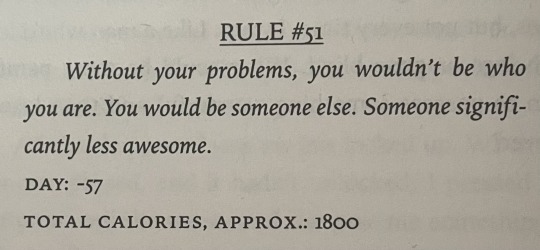
The Art of Starving by Sam J. Miller
#resentful reads#the art of starving#sam j miller#the art of starving rulebook#rule 51#bookblr#book quotes#book excerpt#disordered eating mention#disordered eating recovery#taos#getting better
11 notes
·
View notes
Text
About JJ Mitchell
Full Name: Jeremiah Jedediah Mitchell
Nickname(s):
JJ
Jed (his father)
Mr. America (Alora)
Full-Metal Dickhead (Kabal)
Age: 46
Gender: Male
Place of Birth: Birmingham, Alabama
Date of Birth: July 19th
Star Sign: Cancer
Species/Race: Human
Occupation: Private Military Contractor
Faction: Falcon Company (allied with Special Forces)
Status: Alive

Appearance
Height: 6'0
Weight: 190 lbs
Skin Color: White/Tanned
Hair Color: Salt and Pepper
Eye Color: Hazel
Prominent Features:
Prominent graying near his temples.
Aqualine nose
Hair cropped tight on the sides, longer on top.
Mouth full of too-white, too-straight teeth.
Fighting Attributes
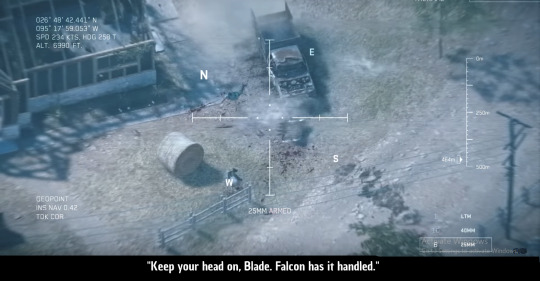
Abilities:
Chaingun - The Glagolev-Shipunov-Gryazev GShG-7.62 rotary machine gun. He can retrieve and mount it for a frenzied gun attack.
Last Resort:
Scorched Earth - Calling in an AC-130 airstrike which obliterates the field.
Skills:
Money, money, money
Has a small personal army at his disposal
Weapons master.
Strengths:
Charming and Disarming - JJ is an expert at defusing situations and charming new contacts. Maybe it's the accent.
Heavy Hitter - He's slow, but when he catches you, watch out!
Pilot - JJ can co-pilot the AC-130 and other heavy warplanes.
Good Leader - Has an entire army at his disposal who are fiercely loyal.
Weaknesses:
Superiority Complex
Slow
Can only pilot with a co-pilot. Cannot land a small plane to save his life.
Storm Trooper aim.
Susceptible to long range
Weapons:
Ruger Security 9 - His primary sidearm
Heckler and Koch HK414
Glagolev-Shipunov-Gryazev GShG-7.62 rotary machine gun
Personality
Traits:
Southern
Cocky to a fault
Quick to anger
Loyal as a starving dog (he'll turn on you for the better bankroll)
Relationships
Enemies:
Black Dragon
Various Other Threats to Earthrealm
Family:
Curtis Mitchell - Father
Carolyn Mitchell - Mother
Siblings unknown
Friends/Allies:
Sonya Blade
Jax Briggs
Johnny Cage
Kombat Kids et all
Kate (formerly)
Other Information
Dislikes:
Waiting around
Closed spaces
Promises not fulfilled
Goals:
Get his bank up, baby
Eventually push Sonya out of the SF and take her place OR
Have Falcon Company become the protectors of Earthrealm
Hobbies:
Horseback riding
Motorcycles
Guitar playing
Likes:
Being the most important one in the room and the center of attention.
Expensive whiskey
Old guns
Habits:
Hums when the air is dead
Uses pet names that piss everyone off
Taps his foot when he's impatient or bored
Fears:
Losing control. Of Falcon Company. Of his life. Of his environment.
Snakes
Enclosed spaces
BIO
Jeremiah Jedediah Mitchell, aka "JJ" was born in Birmingham, Alabama to a family that was nothing of note. His father worked at the steel mill and his mother was a CNA at a longterm care facility.
Jeremiah excelled at his athletic endeavors in high school, but found himself bored with his surroundings. After one semester at BSC, he joined the marines and found his stride. He had a knack for leadership roles and worked well under pressure- enough that he began to attract lucrative offers from PMCs.
But Jeremiah had his sights set higher.
Unfortunately, his humvee was hit by an IED during a tour in Iraq and he lost his leg from the knee down. After his honorable discharge, he started his own PMC, Falcon Company. Such were their escapades that they often attracted the ire of the Black Dragon and various outworld threats.
After a particularly brutal run-in with the Black Dragon, Sonya Blade approached Mitchell and offered him a chance to do something bigger with Falcon Company.
Defend Earthrealm.
The Special Forces has provided him with state of the art prosthetics for his leg, and he considers the injury an upgrade.
Mitchell tolerates Blade and the others, but is biding his time until it's his turn to lead in full. Falcon Company often finds controversy for their fast and loose play with the rulebook.
SHIPS
#HotShot - JJ x Alora (@bihanspookies)
Fun Facts
He did not always have good teeth. He spent a fortune having them veneered.
Codename in the field is FALCON-01
The Latin wording on the PMC's logo reads: Falco Catervae: Alta Volare, which translates to "Falcon Company: Fly High"
He collects antique guns and prides himself on being able to restore them.
His mother is dead, but his father is still alive.
Can play the acoustic guitar quite well.
He does deal with phantom pain in his limb, which he solves with whiskey.
Borrowed most of this template from @bdfightclub thank u beloved fandom creator. HUUUUUUGE shoutout to @bihanspookies for helping with the name and also letting me always borrow Alora <3
#he's unfinished obviously#Mortal Kombat OCs#oc jj#mk jj#anyway he's MR AMERICA!! RAHHH WTF IS A KILOMETER!!!#he's not as old as Andrew in that photo but still#you hear an eagle screech every time he comes on screen
16 notes
·
View notes
Link
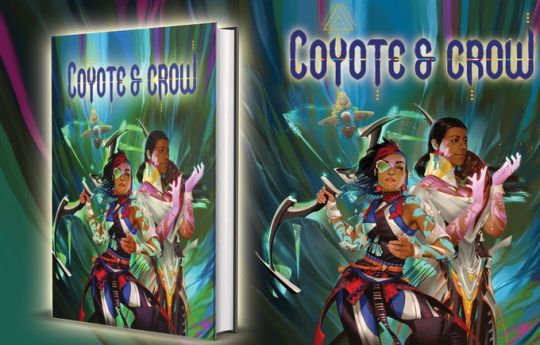
Mock up of the book. Cover design not finalized.

Coyote and Crow is a tabletop role playing game set in an alternate future of the Americas where colonization never occurred. Instead, advanced civilizations arose over hundreds of years after a massive climate disaster changed the history of the planet. You'll play as adventurers starting out in the city of Cahokia, a bustling, diverse metropolis along the Mississippi River. It's a world of science and spirituality where the future of technology and legends of the past will collide.
The game is created and led by a team of Native Americans representing more than a dozen tribes and we've built a game that both Natives and non-Natives will thrill to explore and build upon.

More than 700 years ago, a bright purple streak shot across the night sky. Over the coming weeks, the Earth fell into a deep winter, the seas raged and ash rained from the sky. The event became known as the Awis. As resources dwindled, winter became longer and summer shorter, people struggled to survive. Wars erupted, people starved, some fleeing their ancestral homes before creeping ice sheets.
But people survived. Tribes adapted. And in the wake, people began to notice a strange purple mark appearing on people, plants and animals alike. It became known as the Adahnehdi, the Gift, and many took it as a sign that the Great Spirit had not given up on them.
Eventually, the weather began to ease, the Earth began to heal, and new nations arose. New sciences and technologies, born out of necessity, led to a discovery about the Adahnehdi. It wasn't just a mark, it was a path to abilities and powers, beyond normal human limits.
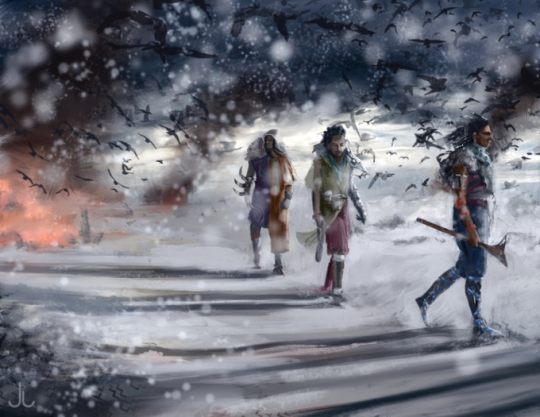
The long walk home. Art by Jennifer Lange
Now, 700 years after the world was brought to the brink, a new chapter has begun. Your characters enter a world that is healing but is no less dangerous. The ice sheets are retreating and the seas are calming, but what lay out beyond your borders? The treaties and alliances that made so much sense during the long winters are now eroding and old grudges between nations are not so easily forgotten. New technologies arise almost every day and the rate of change is frightening for some. And then there are the stories. Talk of spirits, monsters, beings of legend. For so many they were just tales to be told around the fire. But now there is talk that these legends may be far more literal than you may have previously believed. Has something awakened them?

the northern continent of Makasing.

Coyote and Crow is an original role playing system built around the exclusive use of D12 dice. Outside of the core rule book, all you'll need to play the game is some pencil and paper and some twelve-sided dice. While there is some complexity to the game, we are striving to present a system that will allow players to refer to the rule book during play as little as possible, keeping most or all of the critical information on your character sheet.
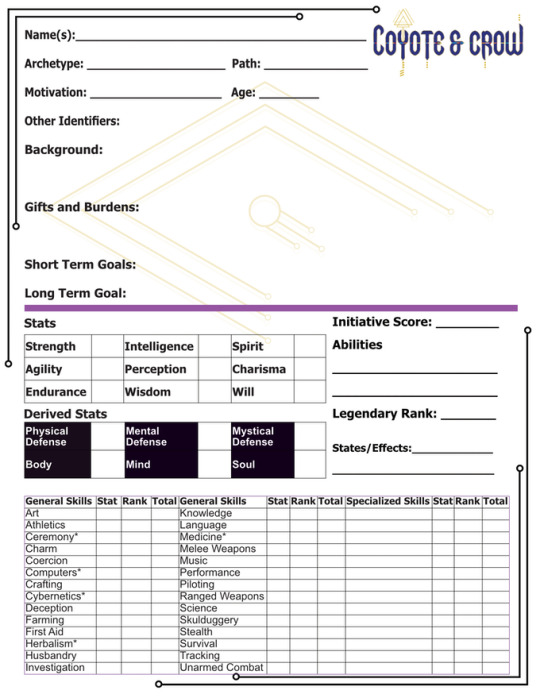
Mock up of the front of a character sheet. Design not finalized.
The basic rule system is centered around collecting a Dice Pool, usually around 5-7 D12s and rolling them to determine either Success or Failure and degree of effect. For example "8" might be the number your Character needs to attempt to do something and every 8 or higher they rolled would be a Success. The more 8's, the more successful they are.
While combat is a part of Coyote and Crow, the game is actually built around the idea of fighting being only one road to story resolution. The game encourages dialogue, building bridges and finding unique solutions to problems that are not always clearly defined by good and evil.
Your Characters have Stats like Strength and Spirit and Skills like Investigation and Charm that are modified by their Stats. In addition, when you create your Character, you choose a Path. That Path determines both certain Stat bonuses you receive as well as which Abilities you have access to. Abilities are powers beyond normal human capability, but not at a level where characters would be comparable to superheroes. There are 15 Paths in the core rule book available. In addition, you'll choose an Archetype (Whisperer, Healer, Scout, among others) that will give you Stat and Skill bonuses and a general idea of your character's profession, but will not force your Character too deeply down a specific progression.
Then you'll choose Gifts and Burdens. These allow you to give your Characters specific bonuses or drawbacks and will help you flesh them out in a way that is flavorful and realistic. It's important to note that the rulebook does not dictate whether something is a burden or a gift for a Player. For example, a Player might choose to give their Character a sister. That might be a Burden or a Gift (or both!) depending on how the Player wants their Character to see that relationship.

Sample pages from the equipment chapter. Layouts and content not finalized.
There are no experience points in Coyote and Crow. Instead, it is built on the Legends system. Your Character will have Short Term Goals, which will increase various numbers on your Character sheets or give them new Skills. But you and your group will also have Long Term Goals. When those are completed your legend will grow. You'll write a short story about your adventures, the kind that can be told around the fire for generations to come. These can change your Gifts and Burdens, give you access to new Abilities and more. As you complete more Long Term Goals, your Character's legend will precede them and your stories will spread.
ARCHETYPES
There are six Archetypes in the game, each acting as a starting point for Character development but not constricting their possibilities. Each Archetype has its own symbol. Here are a few of them.

The icons for the Tinkerer, Warrior and Whisperer Archetypes
PATHS
In addition to Archetypes, Players choose Paths for their Characters, which are permanent associations they make with an animal and help define what extra human Abilities they'll be able to choose from, among other effects. There are fifteen basic Paths in the core rulebook.

The Path of the Badger, the Stag and the Spider

While this game was created by a Native-led team, this game is for everyone. We've taken great care to craft a game that Natives and non-Natives alike will be able to engage in and find themselves immersed in.
For Natives, we've crafted both story and game mechanics that will allow you to integrate your own tribal customs into your play. For those who aren't Native, you'll have a wealth of options to choose from as well as clear guidelines for understanding the differences between this world and our real one.
The game is designed to be your first role playing game or your latest. The core rule book will walk players through every step of how to play Coyote and Crow, but also how to play role playing games in general, including advice on safety and inclusion as well as suggestions on where to find tools outside of the rule book to make your game both easier and more enjoyable.
Everyone involved in Coyote and Crow is deeply passionate about our game and we felt that it was time for Indigenous folks to have a game that didn't see them as secondary, as adversaries, or intertwined with colonialism.
Coyote and Crow is not set in a dystopia. The world went through a dark chapter, but the people of these nations rose to the challenge. There's good food and water, education and meaningful work for almost everyone in Makasing.
But this world isn't a utopia either. It's place that's growing, where old alliances are strained and past slights are not always forgotten. New technology is putting pressure on old traditions. And with the climate becoming milder, there is a whole world of unknowns out there. On top of all of that, there are rumors that some of the old stories about monsters and spirits might just be a little more real than some originally believed. This is a game where science and the unexplained live side by side and sometimes clash.

The Wanderer. Art by Kyle Charles.

THE CORE RULE BOOK
We are producing a beautiful 300+ page hardbound book, loaded with illustrations and containing all of the rules you'll need to play Coyote and Crow. Included in the book (and PDF) will be:
Detailed history of this alternate world
Descriptions of daily life and culture in Cahokia, the capital of the Free Lands
Rules for creating and advancing your characters, including 6 Archetypes, 15 Paths and 27 Abilities for a massive variety of options
Descriptions and stats for mythical creatures, infamous spirits, shadowy organizations and dangerous cults that can challenge players endlessly
A group of pre-generated characters if you want to jump right into playing the game
A starter adventure, Encounter at Station 54, that can act as a stand alone adventure or as the start of a larger campaign
So much more!

It still hungers. Art by Jeffrey Veregge

We have a diverse team of folks working on this game, most of whom are Native. Additionally, we are striving to bring in other marginalized voices whenever possible. Our team features people from across the LGBTQIA spectrum, including two spirit folks. It's not even a question that this game is political. If you have a problem with a game where there are no people of European descent represented, than this game is probably not for you. That said, we've truly built this game to be played by everyone. It might seem like a big leap, but don't worry, we're going to hold your hand the whole way through and you'll be so happy you stepped off the edge into this vibrant fresh world.
===============================================
Kickstarter campaign ends: Fri, April 2 2021 3:00 AM BST
Website: [Coyote and Crow] [instagram]
61 notes
·
View notes
Note
do you have any hc's abt leda? like personality wise or maybe things the twins remember the most about her? i wish we knew more about her 😔🤘 gearbox stop killing mothers of sirens
I have so, so many HCs about Leda. Goddamn. Goddamn.
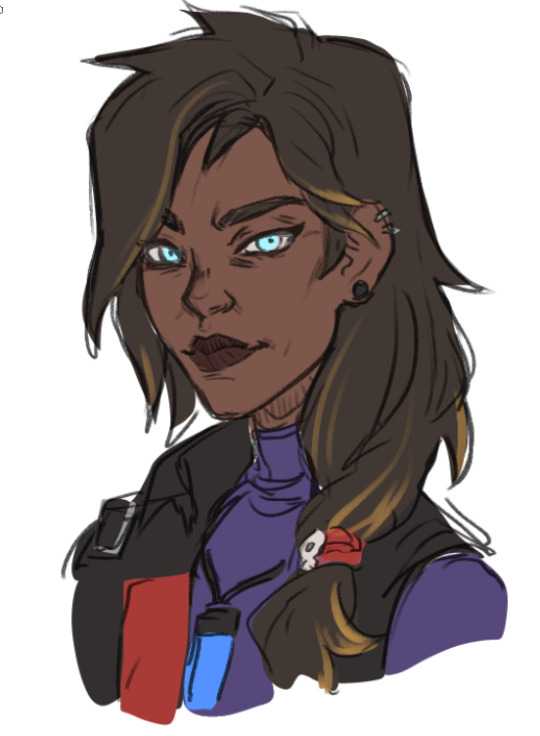
Amazing art courtesy of @lazulizard, saint.
Per Leech Lord AU:
Theme - Spotify link
Physical:
Tall, 6ft, and slender build.
Dark skin, pale blue eyes, deep brown hair with touches of ochre.
Feline features, slight upwards sloping eyes and full lips.
Wavy, voluminous choppy layered hair down to her midback, short layered bangs. Holds it back with a headband and low tie when busy.
Geek/Punky aesthetic. Few lil’ chains and piercings, few small tattoos of Eridian sigils and geometrics, things the twins subconsciously carried into their own aesthetics.
Traits:
Leda was a generally positive person, who had an infectious energy.
Comfortable in herself emotionally and physically, she was the caring, stable adult that offset Typhon’s easily distracted and excitable personality.
Eccentric in her studies, and willing to talk anyone’s ear off about Eridian and Siren lore if they showed a hint of interest when conversing with her.
Very slight lisp, and otherwise flawless pronunciation. Came from a highly learned family.
She was the black sheep of the Calypsos due to her academic interests, and decided to really just solidify that by eloping with some kind of... gremlin man.
Snorted when she laughed.
Leda was an extremely empathic mother, and the parent that showed the most care and affection.
While Typhon worked great as the fun, entertaining, storyteller of the pair, he relied on Leda to do the brunt of the actual parenting.
Small gap between her front teeth.
Excelled in linguistics and spoke multiple languages fluently. Taught the twins the basics of many language cores as they grew, though a lot more of that time was spent with Troy due to his illness and need to stay in bed.
Could not cook anything. Nothing. Would set fire to water. Could follow a recipe like a rulebook and still end up with raw, burnt food. Typhon could not understand how she had lived as long as she had when they met.
Leda was exceptionally slow to anger and was the kind of person to stay worryingly calm in a heated situation. Once she eventually reached her limit, could deliver viciously cutting retorts that would disarm the other party immediately.
Musically inclined and had a strong singing voice.
Extremely argumentative and tended to talk over Typhon a lot. He was quite submissive to her personality in general, and at times defaulted to being meek around her to a concerning level if he thought her mood was dangerous and it could avoid a disagreement.
While very caring to both twins, she ended up giving Troy far more of her time than Tyreen. Not due to preference in any way, simply because Troy was bedridden for so much of his life and needed so much round the clock care that without meaning to, she sometimes left Tyreen starved of attention compared to her brother.
She did pick up on this, and did her best to have days where Typhon would care for Troy and she could spend full time with her understandably attention hungry daughter.
Sadly, more often than not, these days would leave her so concerned over if Typhon was actually meeting their sons needs, that she’d be not as present with Tyreen as she really should have been, which only escalated Tyreen’s deepset feeling of her mother preferring Troy to her.
This was not remotely true, but in reality, Leda didn’t do enough to make that clear, and it was Tyreen who suffered for it.
Leda was a very tactile person, and showed a lot of physical affection to her family. She would absentmindedly run fingers through the twins hair as she sat in bed with them at night and told them stories of her and Typhon’s adventures, massage sore little limbs, stroke narrow shoulders.
Surprisingly competent at sewing, she crafted most of the children’s clothing from her and Typhon’s old clothes as they grew, including being the person to provide Troy with his first simple leather bracer, to “Keep his soft side nice and safe” on the rare days he had the energy to venture outside and play with his sister.
She died when the twins were 8, and their memories of her are simplified. While they each have different feelings towards her, they never really picked up on some of her negatives as they were too young to fully understand them.
Tyreen has a mix of guilt, loss, and confused resentment towards a woman she remembers as craving love from, Troy visualises her as the the kindness, reassurance, and loving care he still chases.
They both hold her on a kind of emotional pedestal that they subconsciously compare both other people they are interested in, and themselves to. Leda was not the immaculate saint they remember her as, but a flawed, wonderful, human woman.
Horrific taste in men. Girrrrlll what you doinnnnn???
Asks are open! Any regarding AU will prob get priority for now as I work to flesh it as we go.
#Anonymous#borderlands 3#borderlands#troy calypso#tyreen calypso#calypso twins#typhon deleon#leda calypso#leech lord#my hcs#my writing
122 notes
·
View notes
Text
Rulebooks are bullshit.
The Art of Starving by Sam J. Miller
#the art of starving#Sam J Miller#lgbtq+ books#lgbtq books#book quotations#quotation#book quotes#quotes#ya books#ya lit'#yalit#ya lit#ya#books read#read#reader#reading#currently reading#literature#lit#bookmark#books#book#booklr#books and libraries#booknerd#bookaddict#bookworm#booklover
6 notes
·
View notes
Text
literature quizzes. repost with your muse’s results for the following quizzes.

HOMERIC EPITHET! / BRIGHT-EYED. you are bright-eyed odo. homer also used this epithet to describe athena, the goddess of things like wisdom, diplomacy, war, and arts and crafts. athena was the patron of odysseus and helped him out of some tough spots, except for those times she just didn’t feel like it for some reason or another.
FATAL FLAW! / YOUR UNCOMPROMISING SENSE OF JUSTICE. when it comes to right and wrong, there’s no gray area. not for you. you’re like a cop who says stuff like, "listen, buddy, i don't make the rules—but I WILL enforce them." look, you’ve got principles, and i get that. i can respect that. but you’re going to wind up dead in a river (JAVERT) if you don’t ease up a little on the rulebook and reconcile these two opposing viewpoints before a convict saves your life and shatters everything you thought you knew.
GREEK MYTHOLOGY DEATH! / KILLED BY YOUR OWN REFLECTION. you spurned the romantic advances of a mountain nymph, so the revenge god has decided to punish you. one day you enter a cave and see your reflection in a pool, and you’re so transfixed by your own beauty [search for self identity] that you decide to just stare at yourself forever. this continues until you either a) starve or b) drown or c) fall upon your own sword out of grief, depending on which poet is telling this story.
LITERARY SETTING! / JULIET’S VERONA HOUSE. you got juliet’s house in verona! not only is verona one of the most beautiful places in italy, it’s also the setting of one of the most iconic love stories of all time—perfect for a hopeless romantic like yourself. you can walk the old-fashioned cobblestone streets, eat your weight in deliciously photogenic gelato, and look out from your balcony at night, waiting for your lover to climb up the wooden trellis and profess their undying affection. just don’t get caught up in any ancient grudges/new mutinies—for your sake, and for the sake of students in english classes for centuries to come.
TAGGED BY : BIG LOVE FOR @mouseminded !
TAGGING : @inthisbeyond / @brashir / @destineyed / @magicaltalents / @empathicstars / @legaciis / @fateprotected / @futurepop / @spacesaved / @onceborg / & anyone else who’d like to do this !
#' you're going to wind up dead in a river (JAVERT) ' ADFGHksdfg#i mean take em with a grain of salt but these were fun#bit clunky but#close enough to home#[ art : godsgrief on tumblr ]#⌀ EVERY SIXTEEN HOURS I TURN INTO A LIQUID! [ about. ]
4 notes
·
View notes
Text
LITERATURE QUIZZES
REPOST with your muse’s results for the following quizzes.
HOMERIC EPITHET! // BRIGHT EYED // You are bright-eyed Vergil. Homer also used this epithet to describe Athena, the goddess of things like wisdom, diplomacy, war, and arts and crafts. Athena was the patron of Odysseus and helped him out of some tough spots, except for those times she just didn’t feel like it for some reason or another.
FATAL FLAW! // YOUR UNCOMPROMISING SENSE OF JUSTICE // When it comes to right and wrong, there’s no gray area. Not for you. You’re like a cop who says stuff like, "Listen, buddy, I don't make the rules—but I WILL enforece them." Look, you’ve got principles, and I get that. I can respect that. But you’re going to wind up dead in a river (JAVERT) if you don’t ease up a little on the rulebook and reconcile these two opposing viewpoints before a convict saves your life and shatters everything you thought you knew.
GREEK MYTHOLOGY DEATH! // KILLED BY YOUR OWN REFLECTION // You spurned the romantic advances of a mountain nymph, so the revenge god has decided to punish you. One day you enter a cave and see your reflection in a pool, and you’re so transfixed by your own beauty that you decide to just stare at yourself forever. This continues until you either a) starve or b) drown or c) fall upon your own sword out of grief, depending on which poet is telling this story.
LITERARY SETTING! // JULIET’S VERONA HOUSE // You got Juliet’s house in Verona! Not only is Verona one of the most beautiful places in Italy, it’s also the setting of one of the most iconic love stories of all time—perfect for a hopeless romantic like yourself. You can walk the old-fashioned cobblestone streets, eat your weight in deliciously photogenic gelato, and look out from your balcony at night, waiting for your lover to climb up the wooden trellis and profess their undying affection. Just don’t get caught up in any ancient grudges/new mutinies—for your sake, and for the sake of students in English classes for centuries to come.
TAGGED BY: @devilglow
TAGGING: you read this you are tagged!
3 notes
·
View notes
Text
The Village Green Preservation Society (Village)

Over the past few years, Inka and Markus Brand have been on fire. The husband and wife designer duo have, in the past three years alone, released the lovely dice-placement racer Rajas of the Ganges (2017), come out with their own sprawling take on the legacy game in The Rise of Queensdale (2018), and played their part in changing the hobby forever with their remarkable Exit series (2016-?).
But if you roll back your calendar a few years, you’ll find a lovely gem of theirs about simpler times. Rather than escaping certain death in Exit or building a grand and majestic estate in Rajas of the Ganges, you are, well, just living your life. Train to be a wainwright or stableman, make your mark, live a long and hopefully productive life, perhaps join the city council or the church, and leave a legacy to be remembered in your small town forever.
Simpler times, indeed.
Village (2011)
Designed by Inka & Markus Brand
Art by Dennis Lohausen
Published by Eggertspiele

Village is, at first glance, a fairly meat and potatoes euro about following four generations of your family through their simple lives in a small village. At its heart, this is a fairly straightforward resource management and conversion game. And yet, unlike so many similar games, there’s a little more than just picking up cubes and converting them into goods–although that’s certainly in the box, as well. Village is proof that the Brands’ inventiveness is no new thing. In addition to cubes, you’ve also got to grapple with time and its slow march forward. Every action takes time, and as time moves forward, those young’ns will grow, eventually becoming well-respected elders, continuing to age until they die and either become part of the village chronicles or are buried in the cemetery and are all but forgotten.
Lowdown (How to Play–in a Nutshell)
Before you ask: yes, it’s about points. Points, points, points.
Colored cubes and action selection combine to define Village. A certain amount of cubes are mixed randomly in a bag before being randomly distributed among a number of action spaces. On your turn, you will take a cube from a space, put it on your individual player board, and then you may take the action from that corresponding space. Each action will have a cost in time, and time is kept on a circular track on your player board.
The colored cubes will accumulate, and soon you will be cashing them in when you select an action in order to convert those cubes into different resources in the form of tokens. One color cube, however, is a plague cube, and if you choose (or are forced) to take a black action cube, you must advance time further.
The actions, which I’ll cover only briefly, are all similar variations on a theme–essentially resource conversion or selling items for points. You can take bags of grain in a harvest (another resource you can convert later or sell to market), grow your family (adding another meeple to your personal board), travel beyond the village (use wagons you’ve made to visit locations for bonuses), craft (cash in your cubes or grain to make wagons, plows, wagons, or buy/raise horses or cows), join the village council (points!), participate in church (points again!), and go to market to fulfill orders by selling your goods (the most points!).
In addition to simply trading in cubes to get other goods like plows or wagons, don’t forget you’ve got those meeples. You’ll often also deploy those meeples as family members to a particular location to make it easier to do that action in the future–essentially because you have trained them in that craft. The idea here is that the second time you need something, like a wagon, you’ll be able to go to your Auntie Edna or Uncle Pete, now trained as a wainwright, and get a wagon spending only time, rather than spending those precious cubes you’ve been hoarding.
When you’ve advanced your timekeeper far enough, however, one of your oldest generation-meeples must die. Slightly macabre, perhaps, but arguably realistic. Those family members will either take one of a few spaces in the village chronicles (for lots o’ points!), or be buried in the village graveyard (for no points!). After the village chronicle or graveyard is full, the game ends. Most points wins.
Tea for Two (Scaling for Two Players)
Each aspect of the games is scalable, with the village chronicle having fewer spaces for two players vs three or four, as well as fewer cubes and fewer market orders for fulfillment. In a two-player game, you’ll have a lower likelihood someone will take a cube you’ve been eyeing, but beyond more limited screwage–which is normal for a two player game vs a three or four player game–scaling is very good here, not really altering the experience at all.
Death to My Hometown (The Bad Stuff)
The mechanics here are very sturdy, albeit typical, euro fare. Take a cube, do an action. Take a cube, place a meeple. Take a cube, convert cubes for tokens. Take a cube, sell tokens. Rinse and repeat. This is a reliable game engine, built on an equally reliable chassis. Many of the actions feel comfortably familiar: harvesting for grain (take a resource) or the “family” action (put out another meeple from your supply), market day (sell for a variable market tile aka convert goods to points). About a half-dozen games immediately come to mind that rely on very comparable actions, and the reliance on cubes here abstracts these actions further, moreso than some of the others. The rulebook states (and I had to look this up because I don’t remember this at all) that orange cubes represent skill, green cubes persuasiveness, brown cubes faith, and pink cubes knowledge. I like that the cubes have some representative analog, but once you play, they completely lose any semblance of meaning beyond their color. A game like Clans of Caledonia (2017) has similar actions (build things, sell things), but feels infinitely less abstracted. Action-wise, Village is not reinventing any wheel.
The other hit Village will take is on the graphic design. A meat and potatoes euro game designed in 2011 looks–today, at least–very dated. It has all the attractive graphic design of a shag carpet and lava lamp. Ten years in board game graphic design is 30 years in fashion or interior design. Board Game graphic design still remains a vulnerable spot in the armor of a great many euro classics, and in that regard, Village is no different. Some publishers have learned a lot since 2011, but even today, Eggertspiel isn’t known for its flashy look. Village is a prime example of their perfectly utilitarian–if nothing to write home about–art and graphic design.
Local Hero (The Good Stuff)
I’d heard a lot about Village prior to playing it, and after reading the rules, I was a little confused about some of the more effusive praise that had been heaped on it. The mechanics are so… generic euro. After playing it, though, I realized something remarkable about it: Village is greater than the sum of its parts.
Being a person of slightly above average cynicism, perhaps, I find it rare to say that about a game. More often than not, I hear about a game and get excited–whether that’s because of the designer, mechanics, theme, art, or some combination of all–only to find the experience of playing it somehow less than the sum of its parts.
So why does Village succeed where other, more immediately engaging or interesting games ultimately fail?
For me, in a nutshell, it’s because of the time mechanic and the familial/generational development. Somehow, a game with a fairly bland and only moderately well-implemented generic euro theme (farming/working in a town/selling stuff, etc) manages to build a story as you play. The story I’m referring to is not actually in the game, mind you. This game does literally nothing to create a narrative for you. There aren’t even basic event cards, like This month there is a storm! Oh no! Better stock up on grain to sell so you don’t starve! Rather, somehow, a story manages to slowly and unassumingly coalesce for you as you play. Let’s say on your first turn you take a meeple and invest the time to train them as a stablehand, becoming skilled at raising horses and cows. You begin to sell your cows at market, and with cows, you’ll be well on your way to a much better harvest, because you’ll now be able to plow for more crops. With more grain, you can fulfill orders, or take those bags to the mill for money (aka points!). Or maybe you’ve got a barfly Uncle (with the expansion, Village: Inn (2013), at least). Maybe he was, over the years, able to buddy up, over a weekly shot and a beer perhaps, with the bigwig Count, guaranteeing that you’ll get more points at the game’s end if someone else in your family is able to visit him by traveling to his faraway castles! Excellent!
Oddly enough, this kind of thing is also present in other games. Giving a meeple a profession does not a story create. To put my finger on it, and I don’t want to sound maudlin, but for me it’s that death mechanic. I’m not exactly a softy, but is remarkably effective, to say nothing of affecting (although that’s may be a slightly-strong word). Your nameless meeples are bestowed with something akin to preciousness as you’re forced to usher them to the village chronicle, or more unfortunately, the graveyard.
Ultimately, there’s something ineffable about Village, something beyond the simple mechanics of it. There’s something remarkable here and worth exploring.
The End (Final Thoughts)
I was a bit flowerier than usual in The Good Stuff, because it’s hard for me to say what works so well about Village, but to turn back to gamier terms, there’s lots of great and satisfying strategy here. Lots of tactical decisions, lots of scrambling to meet objectives, errr I mean market orders. Lots of dilemmas, lots of time management–never enough time, btw–to say nothing of never enough of those dastardly cubes. There’s a lot to manage, but never so much that it becomes overwhelming. There’s new stuff here, but not enough to be daunting or difficult to manage, and it’s a game that is just welcoming enough to be taught to new-ish folks to the hobby. And the time, again, that time. For every first or second generation that you drag your feet to remove from the board, equally interesting is how you may, at times, rush these folks through their lives in hopes of sneaking them into the village’s chronicle before someone else.
So much of this game feels expected, but it’s surprising how much one little wrench can do to the works of a machine and ultimately defy all of your preconceptions. My first impression of the Brands was formed in playing Exit, which duly impressed me. Upon playing Village, however, I was delighted to learn that their seems to be no end to their ingenuity, and I will be keeping an eye out for anything that bears their name.

Player One
Eric
0 notes
Text
LITERATURE QUIZZES: Repost with your muse’s results for the following quizzes.
HOMERIC EPITHET: You are bright-eyed [your name]. Homer also used this epithet to describe Athena, the goddess of things like wisdom, diplomacy, war, and arts and crafts. Athena was the patron of Odysseus and helped him out of some tough spots, except for those times she just didn’t feel like it for some reason or another.
FATAL FLAW: Fatal flaw: Your uncompromising sense of justice.When it comes to right and wrong, there’s no gray area. Not for you. You’re like a cop who says stuff like, "Listen, buddy, I don't make the rules—but I WILL enforece them." Look, you’ve got principles, and I get that. I can respect that. But you’re going to wind up dead in a river (JAVERT) if you don’t ease up a little on the rulebook and reconcile these two opposing viewpoints before a convict saves your life and shatters everything you thought you knew.
GREEK MYTHOLOGY DEATH: You spurned the romantic advances of a mountain nymph, so the revenge god has decided to punish you. One day you enter a cave and see your reflection in a pool, and you’re so transfixed by your own beauty that you decide to just stare at yourself forever. This continues until you either a) starve or b) drown or c) fall upon your own sword out of grief, depending on which poet is telling this story.
LITERARY SETTING: You got “On the road!” Like so many literary characters (Huck Finn, Odysseus, Gulliver, etc.), you’re an adventurer and explorer at heart, and the literary setting that most closely matches your personality is, quite frankly…all the settings! You’re not meant to settle down in one spot—you’re the kind of person who hits up multiple parties in one night, and your insta is probably filled with pics of all the cool places you’ve travelled to. So embrace it! Take to the open road with your friends, run through a field of wildflowers in the middle of nowhere, and please get a pic next to the world’s largest Ketchup bottle.
Tagged by: @untamedtempest
Tagging: everyone!!!
1 note
·
View note
Text
Enjoy An Exclusive Sneek Peek Of: The Art of Starving by Sam J. Miller! (Please Be Aware!! Contains Content Trigger!)
Matt hasn't eaten in days. The hunger clears his mind—and he needs to be as sharp as possible if he's going to find out just how Tariq and his band of high school bullies drove his sister, Maya, away.
Matt has discovered something: the less he eats the more he seems to have . . . powers. The ability to see things he shouldn't be able to see. Maybe even the authority to bend time and space.
Matt decides to infiltrate Tariq's life, then use his powers to uncover what happened to Maya. All he needs to do is keep the hunger at bay. But Matt doesn't realize there are many kinds of hunger…and he isn't in control of all of them.
TRIGGER WARNING:
Eating disorders and body dysmorphia are recurring themes in The Art of Starving by Sam J. Miller. Please be aware if these are sensitive topics for you!
LEARN MORE
TRIGGER WARNING:
Eating disorders and body dysmorphia are recurring themes in The Art of Starving by Sam J. Miller. Please be aware if these are sensitive topics for you!
Congratulations! You have acquired one human body. This was a poor decision, but it is probably too late for you to do anything about it. Life, alas, has an extremely strict return policy.
Not that I’m some kind of expert or anything, but as an almost-seventeen-year veteran of having a body, I’ve learned a few basic rules that might save you some of my misery. So I’m writing this Rulebook as a public service. Please note, however, that there are a lot of rules, and some of them are very difficult to follow, and some of them sound crazy, and please don’t come crying to me if something terrible happens when you can only follow half of them.
RULE #1
Understand this: your body wants the worst for you. It is a complicated machine built up over billions of years, and it wants only two things—to stay alive and to make more of you. Your body thinks you’re still an animal in the jungle, and it wants you to eat ALL the food, and stick your DNA up in anything you can hold down. Lust and hunger will never leave you alone, because your body wants you grotesquely fat and covered in kids.
DAY: 1
TOTAL CALORIES: 3600
Suicidal ideation.
When you say it like that it sounds soft and harmless, like laissez-faire or any of the other weird sets of meaningless words they make you memorize in school. The letter from the psychiatrist sounded so calm I had to read it a couple of times before I saw what she was trying to say. She didn’t quote me. She didn’t tell my mom I said, Sometimes I think if I killed myself everyone would be a lot better off or Five times a week I decide to steal the gun my mom thinks I don’t know about and bring it to school and murder tons of people and then myself.
Instead, the psychiatrist said a lot of scary things in very tame and pleasant language:
Recommend urgent action—
Happy to prescribe—
Facilitate inpatient treatment—
Poor thing. How could she know my mom hides from the mail, with its bills and Notes of Shutdown and FINAL WARNINGS? I didn’t want to go see the psychiatrist in the first place, but the school set it up for me because I am evidently an At-Risk Youth. At risk of what, I wondered, and then thought, oh right, everything. At risk of enough that one or all my teachers filed whatever due-diligence report they’re obligated to file on someone who is obviously headed for homicide or suicide, so his or her blood isn’t on their hands. And as soon as the psychiatrist’s report came, addressed to my mom, I plucked it from the mail pile.
I read it on my walk to school. My mom still thinks I take the bus, but I stopped around the six thousandth time someone called me a faggot and punched me as I walked through the aisle. That kind of thing can really start your day off on the wrong foot. Plus, walking to school makes it easier to get there late, so I’m spared the agony of playing Lord of the Flies while we all stand around outside waiting for the first bell to ring.
The branches were almost entirely bare overhead. Stark and black like skinny fingers clawing at the sky. One crooked tree still had half its leaves. Hunger rumbled in my belly, and I felt like if I reached out hard enough, I could stretch myself taller than any of the trees. Hunger is funny like that.
Anyway. I shredded the letter, let it fall behind me like a trail of breadcrumbs. Lesson learned: Don’t tell people you want to kill yourself. Although really I should have known that one already. If high school teaches you nothing else, know this: Never tell anyone anything important.
I slowed down. Savored my last few steps before the hill crested and brought me in sight of the school. Stared up at the trees, and down the garbage-strewn road. Stopped. Breathed. Wondered what would happen if I turned and walked into the woods and never came back. I thought about this a lot. I had plans. I’d hitchhike or ride the rails or follow the river.
Under my bed there was a bag, full of books and hoodies and diet soda from the vending machine behind the ShopRite, and one of these days I would be ready to sling it over my shoulder and run away for real.
But I wasn’t ready, not yet. As miserable as it made me, I had to go to school. Not because I cared about college or education or a career or any of that pig shit, because anyone who spent five minutes in a Hudson High School classroom would know there was no actual educating happening anywhere in sight. The reason I couldn’t kill myself, and I couldn’t stop coming to school, was because Maya beat me to it. Because five days ago, my older sister ran away from home. She called the next morning from somewhere on the freeway to assure us she wasn’t kidnapped, she was taking a week off (“or whatever”) to go to some studio near Providence to record her band’s first album, she’d catch up on school when she got back. We shouldn’t call the cops. Etc.
She says she’s fine. She says nothing happened. But I don’t think that’s entirely true. I think someone hurt her. And I know who. And I had to keep coming to school because I had to find out what happened, so I could hurt him back.
So I crested the hill and walked down to the squat sprawling one-story building, an ugly heap of aluminum and brick, cursing my abject failure at estimating travel time, for I had arrived too early, and they were there, my peers, my fellow primates, hooting and hollering, pounding chests and grooming each other.
My senses felt like they’d been turned up too high. Maybe it had something to do with skipping breakfast, with the churning engine of my empty stomach generating electricity that danced in my limbs, crackled in my head, but these people stunk. They spoke too loudly.
Their clothes and bags were head-achingly bright. It made every step toward them harder.
And there, at the door, arms folded like the bouncers outside a club in a cop show, they stood. Three of them: Bastien, Tariq, Ott. Hudson High’s soccer stars; the shrewd-eyed roosters at the top of our pecking order.
“Pretty,” Ott said as one girl approached.
“Not pretty,” to the next. Grinning hyena-style at how her face crumpled.
“Pretty.”
“Fugly.”
“Thinks she’s pretty.”
At this, they cackled. Everyone but Tariq. Tariq, with his perfect stomach and impressive chest and a beard thicker than any high school senior’s ever, Tariq of the dimples and broad nose, Tariq who could have stepped out of my computer screen, because he’d fit right in on the sites I spent all night searching when my mom was asleep. Pages packed with boys, beautiful ones—a secret nation to which I would never belong. Tariq, who somehow made me feel fat and scrawny all at once.
Tariq, who saw me and looked away as fast as he could but not fast enough to hide the guilt that soured his face.
We had both been crushed out on Tariq, my big sister and me. He wasn’t like the other boys on the soccer team, even if he did spend an awful lot of time with them. He wasn’t a bully. He was handsome and smart, and even nice, sometimes.
That’s what made him so dangerous. Everybody knows to steer clear of a bully. Maya would never have gone to meet up with Tariq in secret if he had already showed us all he was a brutal thug.
But he seemed . . . human. So she did.
He didn’t know that I knew. And, admittedly, I didn’t know much. Just that they met up that night. So maybe nothing happened. Maybe he just gave her a ride to Providence, to this recording studio I don’t really believe exists, or to where one of her bandmates lived. The fact that he gave her a ride that night wasn’t what made me suspicious. What made me suspicious was this: something shifted, in Tariq’s body language, after that night. He doesn’t look me in the eye anymore. He turns his shoulders away from wherever I am standing.
Like right then, as I approached the front door, where he stood with his best friends, staring at the ground with his perfect lips pressed tight together.
I gnawed my fingernails furiously.
My mom tells me it is a disgusting habit. She tells me to stop. I can’t stop.
It hurt, how much I wanted to smash my face against those perfect lips. I wanted it even though I felt pretty sure Tariq did something terrible to my sister. And the wanting got rolled up with the shame and filled me with a sputtering, stupid animal rage. How could it be, that in spite of everything, I still felt lust when I looked at him? Lust, and hate, in equal measure.
That’s why I’m writing this Rulebook.
Your body is a treacherous savage thing and it is trying to kill you. I am here to help you win. Together, we are both going to win.
Ott saw me stop and stare daggers at Tariq.
“You want something, Matt?”
That’s my name: Matt. I didn’t want to tell you, because I hate it.
A matt is something people step on. A matt is full of filth.
I debated lying. Making up something badass or manly, Damien or Colby or Barrett or Bo, something gay-porn-star-y. But honesty is important. I want you to trust me. Because pretty soon I’ll be telling you some things you’re going to have a very hard time believing.
So, Ott called my name. My whole body twitched with fight-or-flight triggers, but I knew either choice would be disastrous. If I fought, I’d get my ass beat, and if I ran, my limited ability to make Tariq feel uncomfortable, to apply pressure, would evaporate.
People were watching. If Tariq hadn’t been standing there, I’d have gone about my business, but he was my real audience. Ott didn’t matter.
I winced, tasting blood where I bit down too hard on the cuticle of my ring finger.
In movies and books, all you need to do to stop a bully is to punch them back. Bullies are cowards, the story goes; they can dish out violence, but they can’t take it.
This, you should know, if you haven’t already found it out the hard way, is bullshit. I tried it, in middle school, and it made things worse. Maybe it’ll work for you, if you’re stronger than me, or a faster runner, but it earned me a lovely session of puking up blood.
I knew that hitting Ott wouldn’t get me anywhere. But I did see something flicker in his eyes, something like fear but not exactly that, something bigger, messier: hate and fear all at once. I took a step closer. I took a deep breath. I smelled him.
And don’t ask me how, but I knew. I knew from the smell: I made him nervous. I terrified him. My existence, my gayness, threatened his whole way of understanding the world, what it meant to be the male of the species.
I’d never understood the word homophobia before— people who are homophobic are not afraid of gay people, they just hate them! But in that moment it all made sense. Straight men will insult and assault and beat and kill gay men because they are terrified. Because masculinity is the foundation they built their whole worldview on, the set of lies that lets them believe they are inherently better than women, and gay people expose how flimsy and arbitrary the whole thing is.
I turned to him and said, “No, Ott, I don’t want anything. I was just wondering. What about me?”
His mouth curled into a snarl. “What about you?”
“Which one am I?”
He unfolded his arms with a slowness that revealed his uncertainty. “Which . . . one?”
“Yeah. Am I pretty? Not pretty? I definitely think I’m pretty.”
A girl giggled. Even Tariq cracked a grin, though he turned his head to hide it from me.
I took another step forward. Ott’s lips parted slightly, and I saw muscles tighten in his arms. He was confused and getting angry: he sensed I was humiliating him, but not in any way he could reasonably understand. He was desperate for me to touch him, or explicitly insult him, so he could hurt me. I had planned to tap his chest with one finger when I delivered the finishing line, but that would have made Ott feel justified in a physical response. So why bother.
Seconds ticked away—
“You are Not Pretty,” I told Ott an instant before the first bell rang.
Then I slipped by him and walked inside.
TRIGGER WARNING:
Eating disorders and body dysmorphia are recurring themes in The Art of Starving by Sam J. Miller. Please be aware if these are sensitive topics for you!
Original post: http://ift.tt/2taROR5
from Blogger http://ift.tt/2uu7vqf
0 notes
Text
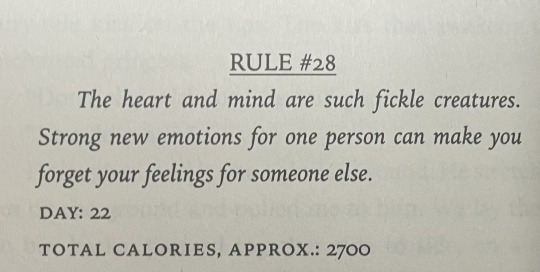
The Art of Starving by Sam J. Miller
#resentful reads#the art of starving#sam j miller#rule 28#the art of starving rulebook#feelings#disordered eating mention#bookblr#book quotes#book excerpt
3 notes
·
View notes
Text
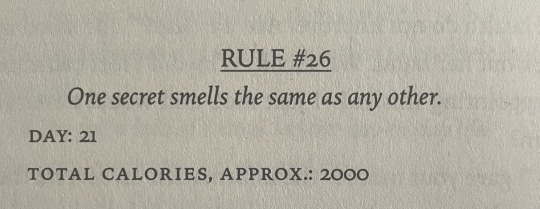
The Art of Starving by Sam J. Miller
#resentful reads#the art of starving#sam j miller#rule 26#the art of starving rulebook#disordered eating mention#bookblr#book quotes#book excerpt
3 notes
·
View notes
Text
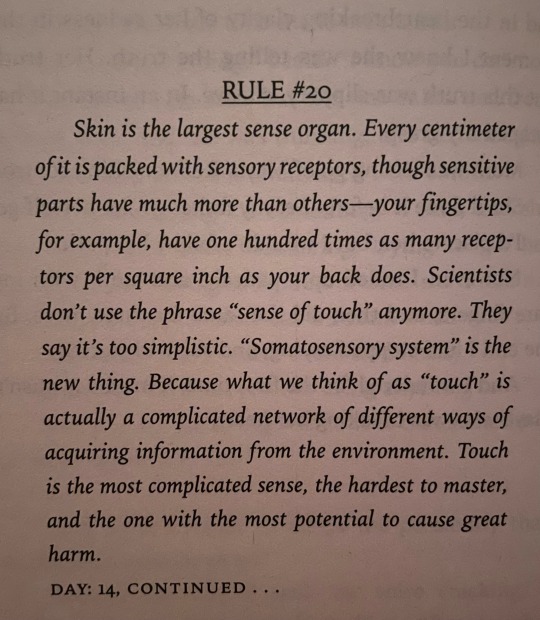
The Art of Starving by Sam J. Miller
#resentful reads#the art of starving#sam j miller#rule 20#the art of starving rulebook#disordered eating mention#bookblr#book quotes#book excerpt
5 notes
·
View notes
Text

The Art of Starving by Sam J. Miller
#resentful reads#the art of starving#sam j miller#the art of starving rulebook#rule 53#bookblr#book quotes#book excerpt#gentle reminders#disordered eating mention#taos
2 notes
·
View notes
Text
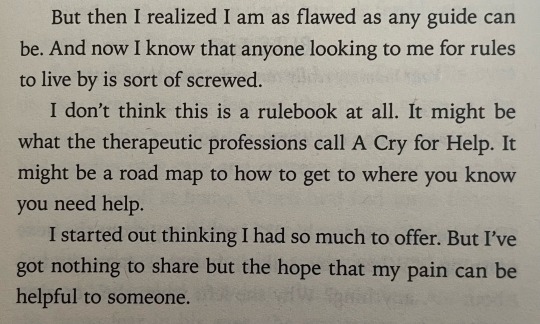
The Art of Starving by Sam J. Miller
#resentful reads#the art of starving#sam j miller#the art of starving rulebook#bookblr#book quotes#book excerpt#we all just trying our beat to get through this thing called life#disordered eating mention
2 notes
·
View notes
Text
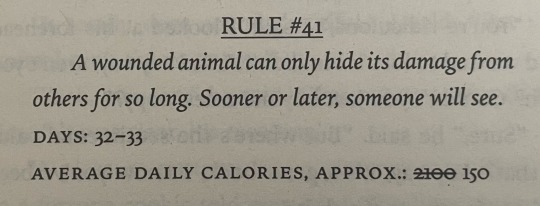
The Art of Starving by Sam J. Miller
#resentful reads#the art of starving#sam j miller#the art of starving rulebook#rule 41#bookblr#book quotes#book excerpt#disordered eating mention#taos
2 notes
·
View notes